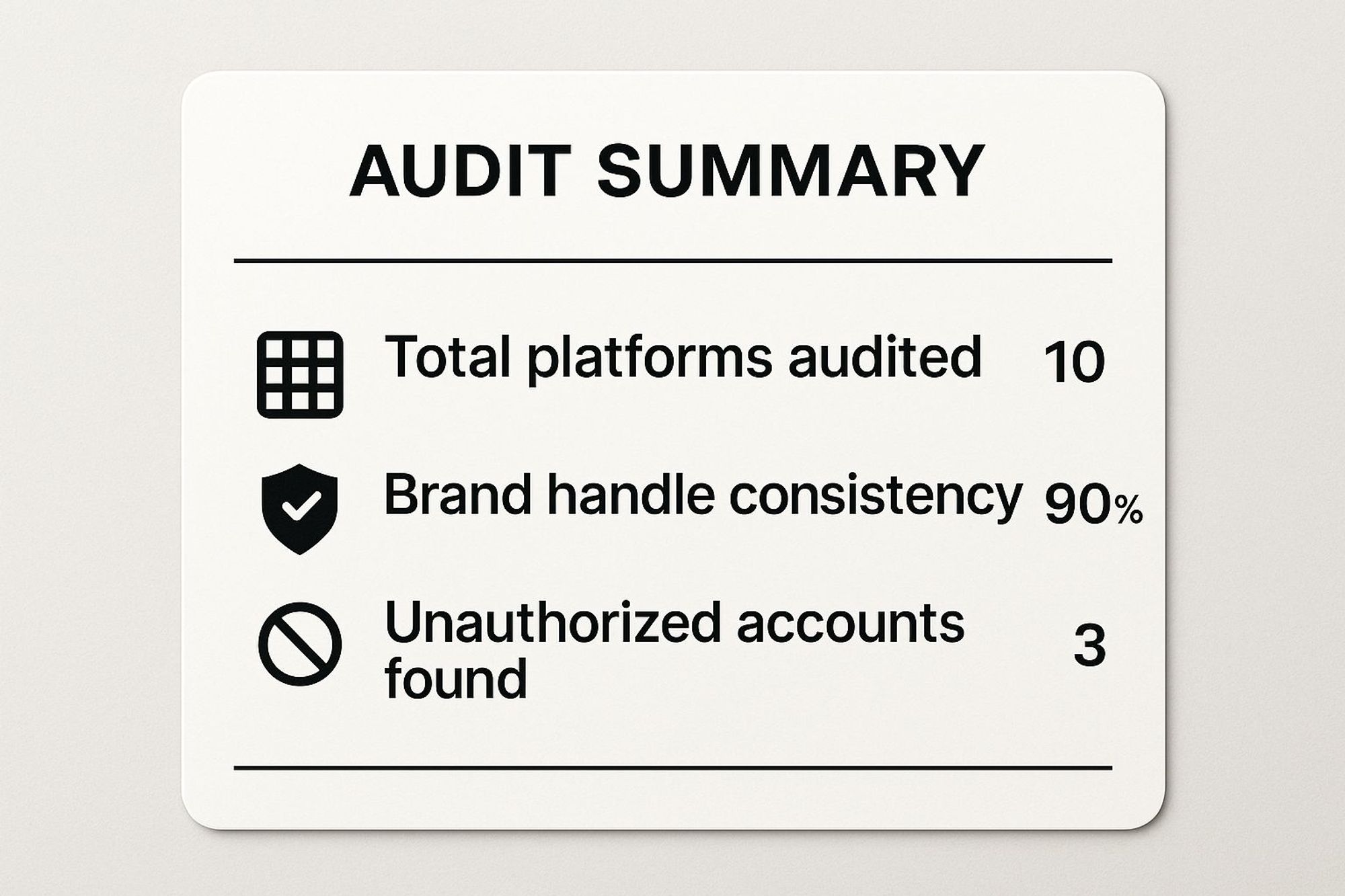Wednesday, June 25, 2025
Your 8-Point Social Media Audit Checklist for 2025


In the fast-paced world of social media, what worked yesterday might not work today. Brands and creators often fall into the trap of posting content without a clear understanding of its impact, leading to wasted resources and missed opportunities. A thorough social media audit isn't just a periodic task; it's a critical business intelligence tool. It provides a clear, data-backed snapshot of your current performance, revealing what resonates with your audience, where you stand against competitors, and how your efforts translate into tangible business results.
This comprehensive guide is designed to walk you through a systematic review of your entire social media presence. To get started, you can utilize a comprehensive social media audit checklist to ensure you cover all essential aspects of your online presence. By following these 8 essential steps, you'll move beyond guesswork and start making strategic decisions that drive growth, engagement, and ROI. This plan will equip you to refine your strategy and achieve measurable success.
1. Account Inventory and Consistency Audit
The first step in any effective social media audit checklist is creating a complete inventory of your digital footprint. This involves identifying every social media account associated with your brand, including official, inactive, or even fraudulent profiles using your name. The goal is to ensure your brand identity, from logos and color schemes to messaging and voice, is consistent across all platforms.
Think of how brands like Nike maintain a unified presence with their iconic swoosh and "Just Do It" tagline everywhere. This consistency builds brand recognition and trust. Without it, you risk diluting your brand message and confusing your audience.
How to Conduct an Account Inventory
To start, create a centralized spreadsheet to document all official accounts. For each platform, list the URL, handle, and login credentials. Next, use brand monitoring tools like Mention or set up Google Alerts for your brand name to discover any unauthorized accounts that could be damaging your reputation. Finally, consider proactively claiming your brand handle on emerging platforms, even if you don't plan to use them immediately, to protect your brand identity.
This infographic summarizes the key metrics you might track during this audit, offering a quick reference for your initial findings.

This snapshot immediately highlights areas for improvement, such as inconsistent handles and the presence of rogue accounts that need to be addressed. By consolidating this information, you establish a clear foundation for the rest of your audit, ensuring brand integrity across the digital landscape.
For a deeper dive into auditing your online presence, this video offers valuable insights:
2. Content Performance and Quality Analysis
Once you have a complete inventory of your accounts, the next crucial step in your social media audit checklist is to evaluate your content's performance and quality. This involves a deep dive into how your posts, videos, and stories are resonating with your audience by analyzing engagement rates, reach, impressions, and conversion metrics. The goal is to identify what works, what doesn't, and where you can optimize for better results.

Think of BuzzFeed's data-driven approach, where they rigorously track content patterns to pinpoint what goes viral. Similarly, Glossier built its empire by leveraging user-generated content, which now drives the vast majority of its social engagement. Analyzing your content reveals the "why" behind your metrics, allowing you to replicate successes and eliminate ineffective strategies.
How to Analyze Content Performance
Start by gathering data from the last 3 to 6 months to ensure you have a meaningful sample size. Use each platform’s native analytics tools to export key metrics like likes, comments, shares, video views, and click-through rates. A thorough content audit should also examine the underlying strategies and processes, including how effective content systems are integrated into your workflow to ensure consistent quality and performance.
Create a spreadsheet to compare content types (e.g., video vs. image vs. text), post formats (e.g., Reels vs. Stories), and messaging themes. This analysis will highlight your top-performing content, providing a clear roadmap for your future content strategy and ensuring every post serves a strategic purpose.
3. Audience Demographics and Engagement Audit
Understanding who you're talking to is fundamental to social media success. This part of your social media audit checklist involves a deep dive into your follower demographics, behavior patterns, and engagement quality. The goal is to ensure your content strategy aligns perfectly with the preferences of your actual audience, not just the audience you think you have.
Think of how Sephora uses detailed audience segmentation to deliver personalized beauty content that resonates with specific age groups and interest clusters. This targeted approach boosts relevance and drives higher engagement because the content feels tailor-made for the viewer. Without this analysis, you're essentially creating content in the dark, hoping it connects.
How to Conduct an Audience and Engagement Audit
Start by using the native analytics tools on each platform (like Facebook Insights or Instagram Analytics) to gather demographic data such as age, gender, location, and language. Compare this data against your ideal customer personas to identify any misalignments. Next, analyze engagement quality by looking at comments and shares, not just likes. Are the comments substantive, or are they from bots? A regular follower audit helps clean your audience by removing fake or inactive accounts, which improves your engagement rate and data accuracy.
For a deeper dive into improving your audience connection, you can learn more about how to increase engagement on social media on schedulethreads.com. This resource provides valuable strategies for turning passive followers into an active community. By creating content that truly speaks to your followers' interests and pain points, you build a loyal base that supports your brand's growth.
4. Competitor Analysis and Benchmarking
An essential part of any comprehensive social media audit checklist is looking beyond your own accounts to evaluate your competitors. This involves a systematic review of their social media strategies, content performance, and audience engagement to identify industry benchmarks and uncover strategic opportunities. Understanding what works for them, and what doesn't, provides invaluable context for your own performance.
Consider how Dollar Shave Club analyzed the staid marketing of traditional razor companies like Gillette. This informed their disruptive, humor-led social media strategy that directly challenged the industry leader and carved out a new market segment. This level of analysis is crucial for strategic positioning and gaining a competitive edge.

How to Conduct a Competitor Analysis
Begin by identifying 5-10 direct competitors and 3-5 aspirational brands, even those outside your industry, for inspiration. Create a spreadsheet to track their key metrics, such as follower count, engagement rates, post frequency, and content formats. Focus on identifying their most successful tactics and note any content gaps you could fill.
This analysis helps you set realistic goals and avoid repeating others' mistakes. By regularly monitoring the competitive landscape, you can adapt quickly to emerging trends and maintain a strategic advantage. For a more detailed guide on the best tools to streamline this process, you can explore various social media competitor analysis tools available online.
5. Brand Voice and Messaging Consistency Review
Beyond visual identity, a crucial part of your social media audit checklist involves evaluating how consistently your brand's personality and key messages are communicated. This means ensuring your tone, values, and core messaging are aligned across all platforms and content types, from a witty tweet to a formal LinkedIn article.
Consider how Patagonia masterfully weaves its environmental activism into every post, creating a powerful and authentic brand identity. This consistency ensures that no matter where a follower interacts with them, they receive the same clear message. An inconsistent voice can confuse your audience and undermine the trust you’ve worked to build.
How to Review Your Brand Voice
Start by creating a social media style guide that defines your brand's personality, tone, and key messaging pillars. This document will serve as the benchmark for your audit. Next, review a sample of recent posts from each platform, asking questions like: "Does this sound like our brand?" and "Does this support our core values?" When evaluating your approach, looking at strong brand voice examples can provide inspiration and a clear standard for what works. Finally, create a simple approval workflow to ensure all future content is vetted for voice and messaging alignment before it goes live, keeping your team on the same page.
By systematically auditing your brand voice, you reinforce your identity and build a more genuine connection with your audience. This step ensures every post contributes to a cohesive and memorable brand story.
For a comprehensive guide on aligning your messaging, you can learn more about developing a brand positioning framework. Learn more about brand positioning frameworks on schedulethreads.com
6. Security and Privacy Compliance Assessment
A crucial part of any comprehensive social media audit checklist involves assessing your security protocols and privacy compliance. This step goes beyond content performance to safeguard your brand against cyber threats, data breaches, and potential regulatory penalties. It requires a thorough review of account security measures, privacy settings, and data protection policies to ensure they are robust and up-to-date.
Think of how high-profile account hacks on platforms like Twitter forced a complete overhaul of API security measures. Similarly, Facebook’s response to the Cambridge Analytica scandal involved enhancing privacy controls for users and businesses. Proactively managing these risks protects your brand’s reputation and your audience's trust.
How to Conduct a Security and Privacy Assessment
Start by auditing who has access to your accounts. Create a list of all users with login credentials and their permission levels, removing anyone who no longer needs access. Next, enable two-factor authentication (2FA) on all company profiles; this is one of the single most effective security measures you can implement. Regularly audit and revoke access for any unnecessary third-party applications connected to your accounts.
Develop a clear social media security policy and an incident response plan outlining the exact steps to take in case of a breach. Enforce strong, unique password requirements for each platform, ideally managed through a secure password manager. Staying informed about platform-specific security updates and privacy policy changes is also vital for ongoing protection.
For more insights into platform-specific security measures, you can learn more about privacy and security concerns on emerging platforms.
7. Platform-Specific Optimization and Feature Utilization
A critical component of a modern social media audit checklist is evaluating how well you leverage each platform's unique features. Cross-posting the exact same content everywhere is a missed opportunity, as each network has its own algorithm, user expectations, and engagement tools. True optimization means tailoring your strategy to maximize reach and interaction on a per-platform basis.
Consider how major brands excel by speaking the native language of each platform. Netflix uses intricate Twitter threads for storytelling, while Chipotle’s early adoption of TikTok challenges created massive viral engagement. This platform-specific approach demonstrates a deeper understanding of the audience and drives significantly better results than a one-size-fits-all strategy.
How to Audit Feature Utilization
Start by creating a checklist of key features for each of your active platforms, such as Instagram Reels, Stories, and Guides, or LinkedIn Articles and Polls. Go through your recent content and mark which features you've used and how often. Compare your usage against top-performing competitors to identify gaps and opportunities for experimentation.
Next, analyze whether your content format aligns with platform best practices. Are your videos vertically formatted for mobile-first platforms like TikTok and Instagram? Are you using interactive elements like polls and Q&A stickers to boost engagement? This audit should reveal where you can innovate and better align your content with user behavior, which is essential for any comprehensive social media audit checklist. For more on managing these diverse strategies, you can explore various social media management tools on schedulethreads.com that help streamline platform-specific posting.
8. ROI and Conversion Tracking Analysis
Ultimately, social media efforts must contribute to tangible business objectives. This part of the social media audit checklist moves beyond engagement metrics to evaluate the financial impact of your activities. It involves a detailed analysis of how social media drives conversions, attributes revenue, and delivers a return on investment (ROI).
Pioneers like Avinash Kaushik have long advocated for tying social media actions to measurable outcomes. Without this, you're essentially flying blind, unable to justify budgets or optimize campaigns for profitability. For example, HubSpot’s ROI dashboards effectively trace leads back to specific social posts, proving their value beyond simple likes and shares.
How to Analyze ROI and Conversions
Start by implementing rigorous tracking mechanisms. Use UTM parameters on all shared links to monitor traffic sources accurately in Google Analytics. Set up conversion tracking pixels (like the Meta Pixel or TikTok Pixel) on your website to attribute sign-ups, leads, and sales directly to social campaigns. This data is crucial for calculating metrics like cost-per-acquisition (CPA).
Next, create dedicated goals within your analytics platform for social media traffic, such as newsletter sign-ups or demo requests. Analyze both direct ROI from "click-to-buy" actions and assisted conversions where social media played a role in the customer journey. This provides a complete picture of its influence, helping you build a stronger business case for your social media strategy.
8-Point Social Media Audit Comparison
| Item | Implementation Complexity 🔄 | Resource Requirements ⚡ | Expected Outcomes 📊 | Ideal Use Cases 💡 | Key Advantages ⭐ |
|---|---|---|---|---|---|
| Account Inventory and Consistency Audit | Moderate to high; detailed account review | Medium; requires tools and ongoing updates | Unified brand presence; detection of unauthorized accounts | Brand protection; multi-platform consistency | Prevents impersonation; brand reputation protection |
| Content Performance and Quality Analysis | High; requires data analysis expertise | High; analytics tools and skilled analysts | Identification of top content; optimized posting | Content strategy refinement; maximizing engagement | Data-driven insights; eliminates low-performing content |
| Audience Demographics and Engagement Audit | Moderate; demographic and engagement analysis | Medium; analytics tools and periodic surveys | Precise targeting; audience insight | Audience segmentation; personalized content | Improves targeting; reveals engaged segments |
| Competitor Analysis and Benchmarking | Moderate; requires competitor data gathering | Medium; competitive intelligence platforms | Market gaps identified; benchmarking performance | Strategic positioning; competitive advantage | Reveals opportunities; avoids competitor mistakes |
| Brand Voice and Messaging Consistency Review | Moderate; evaluation across content types | Medium; training and ongoing audits | Cohesive brand messaging; enhanced recognition | Brand consistency; multi-channel communication | Builds loyalty; strengthens brand differentiation |
| Security and Privacy Compliance Assessment | High; complex regulatory and security audit | High; security expertise and monitoring | Protection from breaches; regulatory compliance | Risk management; data protection | Prevents hacks; ensures legal compliance |
| Platform-Specific Optimization and Feature Utilization | High; continuous adaptation to platform changes | High; platform expertise and resource allocation | Maximized reach and engagement per platform | Leveraging platform features; staying current | Competitive advantage; improved content performance |
| ROI and Conversion Tracking Analysis | High; complex attribution and tracking setup | High; analytics tools and cross-platform data | Clear ROI; informed budget allocation | Business impact measurement; investment justification | Demonstrates value; directs budget to best channels |
From Audit to Action: Implementing Your Findings for Lasting Growth
You have now worked through a comprehensive social media audit checklist, a significant step toward refining your digital strategy. This process is more than just a box-ticking exercise; it's a strategic deep dive into what makes your brand's social presence tick. From assessing your account consistency and content quality to analyzing competitor benchmarks and ROI, you've gathered invaluable data. The true power of this audit, however, is unleashed in the actions you take next.
Think of your completed audit as a strategic map. It highlights your strengths, pinpoints weaknesses, and reveals untapped opportunities. Your next challenge is to translate these insights into a concrete, prioritized action plan. Don't try to tackle everything at once. Instead, categorize your findings to create a clear path forward.
Your Post-Audit Action Plan
- Quick Wins: Identify the most straightforward fixes that can yield immediate results. This could be updating outdated profile bios, removing underperforming content, or standardizing your brand voice across all platforms.
- Strategic Shifts: Pinpoint the larger, more impactful changes. This might involve reallocating your budget to higher-performing platforms, overhauling your content strategy based on audience engagement data, or developing a new approach to competitor benchmarking.
- Ongoing Monitoring: Establish a system for continuous improvement. This includes setting up better ROI tracking, scheduling regular security checks, and creating a process for staying updated on new platform features.
By transforming your findings into a documented plan with clear timelines and assigned responsibilities, you move from analysis to achievement. This disciplined approach ensures the effort you invested in the audit pays dividends in the form of sustainable growth, deeper audience connection, and a stronger bottom line. Remember, a social media audit is not a one-time task but a recurring cycle of review, refinement, and renewal. Make this social media audit checklist a cornerstone of your quarterly marketing routine to keep your strategy agile, effective, and always aligned with your business goals.
Ready to put your audit insights into action? Schedul helps you manage, schedule, and analyze your content on X (Twitter) and Threads, making it simple to implement your new strategy and track its performance. Start streamlining your social media workflow with Schedul today.
No credit card required!